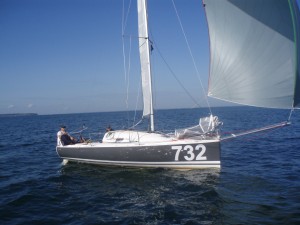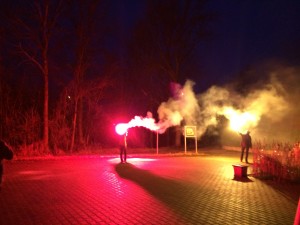Of sprints and brouhahas
In my job as a software developer we organize our work following the “Scrum” model for agile software development.
That is a methodology where the work is split up in “sprints” that have a fixed length (e.g. 4 weeks). At the end of each sprint there should be a piece of software that is runnable (i.e. works).
That is different from the classic approach where one defined a set of requirements that had to be implemented which were then organized in a long and very detailed planning phase which was then followed by an very long and often delayed implementation phase.
By using sprints the risk of missing the mark and/or the deadline is highly reduced. One can react quicker to changing parameters (e.g. available time/resources) and still end up with a usable product that might have less features than originally planned but is ready at a predetermined time.
As I looked at the list of open todos that need to be done (some of them need to be ready by April 13th for the Select 6.50, others for the Acores race in july) I realized how much that resembled a software development project.
The target “product” is the combination of a race-ready boat and a well prepared skipper.
So I decided to treat my preparation as an agile project now and split the available time into sprints at which end both me and the boat should always be ready to leave for a race immediately.
And that might sound easier than it is considering that my todo list currently spans rigg work (trimming the mast, splicing halyards), electrics (fuse box is messy, fuel cell needs to be installed), electronics (data logger needs to be rewired, collision alert has to be wired) and personal preparation (fitness, meteo).
But this also sounds familiar from my job as a software developer. When working on a software component we often have to juggle different aspects that all have to be worked on more or less in parallel, e.g.: adding new features, fixing bugs, optimizing performance, interface definition, writing documentation, etc.
Now since the effectiveness of your work is considerably lower when you often have to switch from one area to the other we will often add so called “brouhaha”s to our sprints.
A brouhaha is a timespan of 2 to 5 days in which we will focus entirely on a specific area of work, e.g. performance optimization. It is incredible how much progress one can make by focussing on a specific area of work for some days.
So I will adapt this as well to my race preparations and add brouhahas to my sprints where it seems a good fit to finish a certain aspect of race preparation quickly and soundly.
So, sprints and brouhahas will be a frequent topic for weeks and months to come. It’s only 4 1/2 months left till the start of the acores race and until then more than 2000nm will need to be sailed successfully!
Did you know? #1: Bowsprit
 I’m starting a new category themed “Did you know?” which will feature brief infos around shorthanded sailing, mini sailing and sailing in general. Here we go:
I’m starting a new category themed “Did you know?” which will feature brief infos around shorthanded sailing, mini sailing and sailing in general. Here we go:
The bowsprit (the boom at the bow of the boat that we use to hoist the big down wind sails) of a mini series boat is 2.40m, the ones of protos are even 3.00m long.
That is 46% of the boat length (!).
If you applied the same to an Open 60 (the much bigger siblings of the minis) its bowsprit would be almost 8.50m long!
Preparations: ISAF & the Doc
The last three days were all about getting ready for the new season.
 Saturday and Sunday I spent in Woergl, Austria to renew my required ISAF Safety at Sea certificate. The training was held by ex-Volvo Ocean Race skipper Andreas Hanakamp who managed to convey all the information in a very lively and interesting way.
Saturday and Sunday I spent in Woergl, Austria to renew my required ISAF Safety at Sea certificate. The training was held by ex-Volvo Ocean Race skipper Andreas Hanakamp who managed to convey all the information in a very lively and interesting way.
Compared to the training at the german navy 5 years ago in Neustadt/Holstein this training was a lot more focused on sailing boats but we also talked a lot about chartering boats due to the audience.
After all a great training and a good refresher on some topics.
This afternoon then it was time for the medical checks.
In order to participate in the acores race we are required to undergo some medical checks.
First there was the echocardiogram whose results were that – in my ears – my heart sounds like a train but all is good. It was eery to see your own heart pumping on the screen.
After that I did the stress-ECG where they ramped me up to 200W and also turned out ok.
That means that the last “paper”-hurdles have fallen in order to qualify for the acores race this year. All that’s “left” is to complete one race and to finish my 1000nm qualifier.
But until at least June 30th my registration should be ok.
So with those things out of the way it’s time to make sure the remaining equipment which needs to be bought, repaired is done but things also look promising on that front: Structures finished the new rudders and they’re waiting for me to pick them up, the boat should be leaving the yard and day now and only the sailmaker has some things to finish.
Next week it’s time to put the mast back into the boat and get the boat back into a race-ready condition. Can’t wait!
A short video of the 2013 season
I finally got around to compile a couple of the gigabytes of video footage from last year into a short video. Most of the sequences were shot during the Pornicht Select (e.g. the upwing stuff). There’s much more material I haven’t had the chance to look into yet, maybe some other time.
At least it’s a small teaser for the new season and what might come in 2015…
enjoy!
PS: Thanks to Frank for the footage of me with the big kite up